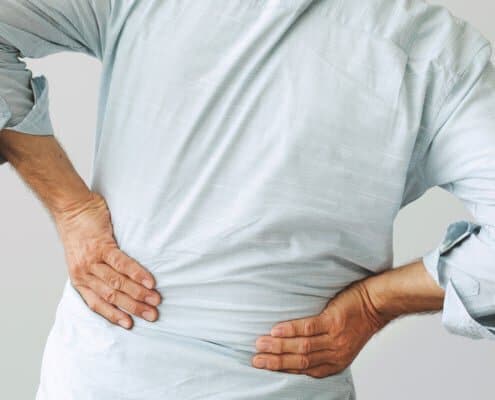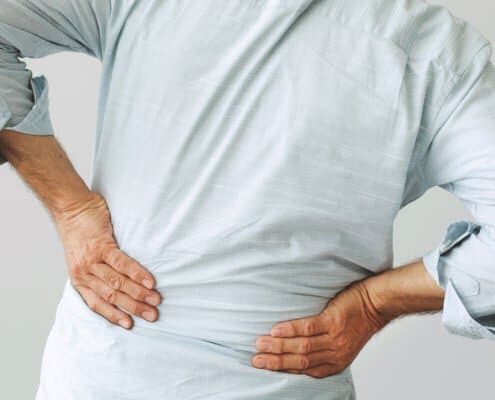
Spinal stenosis is a unique medical condition in which compression of the spinal cord and nerve roots occur. Basically, it narrows the spaces in the spine reducing space for the nerves. The most common cause can be wear and tear in the spine with age. Patients may experience symptoms such as weakness in the legs and arms, pain in the neck and back, tingling, numbness, and more. The pain involved can be mild to moderate in most cases and it can be treated in various ways like physical therapies, medications, self-care techniques, injections, and rarely, surgeries.
In this article, our pain doctors have compiled all the necessary information you should know about this condition. At the end of this writeup, you will be aware of major symptoms, causes, and types of spinal stenosis along with its treatment options.
What Is Spinal Stenosis?
When one or more spaces in the spine narrow and reduces the space for nerves and cord, it is called spinal stenosis. The compression can irritate nerves and the spinal cord that eventually results in sciatica and back pain.
This is a time-consuming medical condition. As you age, your spine goes through various changes along with wear and tear. While it happens naturally in most cases, some patients may have this condition due to osteoarthritis. Many patients do not feel any symptoms of this for the same reason even though their x-rays or other diagnostic tests have shown changes in their spine. The severity of the symptoms depends on the location and level of the condition.
Where Does This Usually Occur?
Spinal stenosis mainly takes place in one of the two areas mentioned below.
Note that in some rare cases, it may occur in any other location along the spine. When it occurred in the neck it is called cervical spinal stenosis and when it occurs in the lower back, it is called lumbar canal stenosis.
Cervical Spinal Stenosis
It involves the compression in the spinal canal of the neck area. It mostly occurs with adults aged 50 or more and can exhibit neck pain and other problems. Narrowing of the spinal canal in the neck is caused due trauma or degenerative changes. If the spinal canal is compressed too much, patients may fall victim to another condition called myelopathy.
The most common symptoms of cervical spinal stenosis are loss of coordination in multiple limbs, numbness, pain, weakness, and decreased functionalities.
Lumbar Canal Stenosis
Our nerves communicate with the spinal cord through tunnels. In lumbar canal stenosis, these spinal tunnels get narrowed and make it difficult for nerves or other structures to communicate. It happens due to the aging factor and the changes associated with it.
Canal compression pinches the nerves of the cord and makes it significantly irritated. It affects the lower back primarily including the groin, buttocks, and hips. Weakness in the legs is also a common effect of this condition. Patients may experience intense pain while standing or walking. Activities such as leaning forward slightly, laying down, and sitting can ease the pain.
Who Is More Prone To Spinal Stenosis?
Anyone can develop this medical condition; however, men and women older than 50 or more are highly prone to it. People who have birth defects such as narrow spinal cord can experience this as well. Other than this, injuries or a condition like scoliosis can put you at the risk of developing this disease.
What Are The Causes Of Spinal Stenosis?
Spinal stenosis can occur due to many causes. However, one thing is common between all the causes — compression in the spinal canal that reduces the space around nerve roots and spinal cord.
The following are the primary causes of spinal stenosis.
Bulging Discs Or Herniated Discs
Our spine has shock absorbers. Technically, they are round cushioning pads between every vertebra and are also known as vertebral discs. With age, such discs get damaged and it causes the center of the discs to break through a torn or weak outer layer. This affects the nerves located near the disc.
Spinal Cord Cysts Or Tumors
The narrowing can occur in the spinal canal due to the growths between the vertebrae and spinal cord or within the cord itself. Due to the increased pressure on the nerves and spinal cord, spinal stenosis occurs.
Thickened Ligaments
The job of holding the spine together is done by ligaments which are nothing but fiber bands. Thickening of ligaments occurs due to arthritis and it results in bulging into the spine. Ultimately, it leads to spinal stenosis.
Congenital Spinal Stenosis
This is a birth defect in which the patient has a relatively smaller spinal canal since his or her birth. Scoliosis is another congenital spinal deformity in which the spine is abnormally shaped and that can lead to spinal stenosis.
Arthritis Spurs Or Bone Overgrowth
Breaking of cartilage located in our joints can be the result of age-related wear and tear and this phenomenon is usually known as osteoarthritis. While cartilage protects the joints, damage to it can cause bones to rub against each other. Our body focuses on bone growth to combat this and eventually leads to bone overgrowth. When this happens with the joints located in our spinal cord, it reduces the space and makes bones pinch the nerves in the spine. Medically, this condition is known as bone spurs. Apart from this, there is one more condition that can result in overgrowth of the bones in the spine — Paget’s disease.
What Are The Symptoms Of Spinal Stenosis?
Patients with spinal stenosis often do not exhibit any symptoms initially. As mentioned earlier, it takes a lot of time to develop and gets worse as you grow up. Even though any part of the spinal column can have spinal stenosis, neck and lower back are the most common areas. In some cases, symptoms can be intermittent but they vary from patient to patient.
Symptoms Of Cervical Spinal Stenosis
- Loss of bowel or bladder control
- Weakness in the foot, arms, leg, or hand
- Balancing issues
- Neck pain
- Difficulties in hand functioning
- Numbness in the arm, leg, foot, or hand
Symptoms Of Lumbar Spinal Stenosis
- Cramps in legs
- Lower back pain
- Sciatica
- Loss of bowel or bladder control
- Pain that reduces when you lay down, sit, or lean forward
- Numbness in legs or buttocks
- Pain worsens when you stand or walk
- Weakness in legs
Symptoms Of Abdomen Spinal Stenosis
- Balancing problems
- Numbness or pain in the lower abdomen
Can Permanent Paralysis Occur Due To Spinal Stenosis?
No. Spinal stenosis does not usually lead to permanent paralysis in the first stage. But if left untreated, the prolonged compression of the spinal cord can cause permanent paralysis or permanent numbness. For this reason, we suggest visiting a pain doctor if you feel weakness or numbness in your legs or arms.

What Are The Treatment Options For Spinal Stenosis?
Treatment of spinal stenosis depends on the following factors:
- Severity of symptoms
- Location of the issue
- Cause of the problem
Most pain management doctors suggest self-care techniques for mild symptoms. If they fail, you may undergo physical therapy, medications, and even surgery.
What Are Self-Care Techniques To Ease Pain In Spinal Stenosis?
Regular Exercise
Exercising relaxes muscles in the affected area and enhances balance and flexibility in the spine. It is a great way to ease the pain; however, you should have a word with your pain doctor before engaging in this activity.
Apply Heat
This is a perfect option to relieve pain for osteoarthritis patients. By improving the blood circulation in the affected area, heat causes muscle relaxation and pain relief. But you need to be very cautious while applying the heat as setting it too much can get your skin burned.
Apply Ice Packs
You can use an ice pack or frozen bag if the heat does not offer any relief. Try applying a cold pack for 20 minutes on and off. It helps in lessening inflammation, tenderness, and swelling.
What Are The Non-Surgical Treatments For Spinal Stenosis?
Physical Therapy
With the assistance of a professional physical therapist, you can develop an exercise plan to improve the flexibility and balance of your spine. Therapists can also guide you on how you can walk in order to deliver relief to the spinal canal.
Oral Medications
Pain doctors may suggest medications for reducing the inflammation and offer relief for the spinal stenosis patients. Such medications include NSAIDs (nonsteroidal anti-inflammatory medications) like aspirin, naproxen, or ibuprofen.
Decompression Procedure
Medically known as percutaneous image-guided lumbar decompression (PILD), this helps in the treatment of mainly lumbar spinal stenosis. Note that this is an outpatient medical treatment.
Steroid Injections
Inflammation and pain can be reduced by injecting corticosteroids in the affected areas — where nerves are pinched and bones are rubbing against each other. As such injections can weaken bones and tissues, it is mostly given three to four times per year.
What Are The Surgical Treatments For Spinal Stenosis?
When doctors recommend surgery, it often includes the removal of tumors or bones that are causing problems. The following types of surgeries can be part of this treatment:
- Laminotomy
- Spinal fusionForaminotomy
- Laminectomy
- Interspinous process
- Laminoplasty
Final Words
Most spinal stenosis patients live a perfectly active life. All they have to do is to follow certain guidelines suggested by their pain doctors to ensure the safety of their spinal cord. They may also need to modify their several physical activities. In rare cases, patients may experience residual pain after undergoing specific treatment or surgery.




